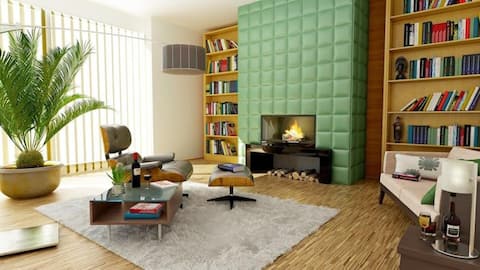Embracing nature in home decor: The power of biophilic design
What's the story
In our fast-paced, technology-driven world, creating spaces that foster well-being and a connection to nature has become more important than ever.
Incorporating elements of nature into home decor offers numerous benefits, enhancing physical and mental health, boosting productivity, and creating aesthetically pleasing environments.
Tushar Joshi from Utkarsh Vastukarn shares his expert insights on the transformative power of biophilic design.
Relaxation
Reducing stress and boosting mood
Biophilic design significantly reduces stress by incorporating natural elements such as plants, water features, and natural light.
These features promote relaxation by calming the mind and body.
Additionally, ample natural light and good ventilation enhance mood and energy levels, making spaces feel more inviting and uplifting.
Overall, this approach boosts well-being by creating a positive, energizing environment.
Productivity
Enhancing cognitive function and sleep
Biophilic design significantly enhances cognitive function, focus, creativity, and productivity by creating a strong connection to nature.
The incorporation of earthy colors and nature-inspired palettes creates a serene, balanced environment, making interiors both functional and visually pleasing.
Moreover, integrating natural light-dark cycles into home decor not only regulates sleep patterns but also promotes better sleep quality.
Indoors
Improving air quality and organic feel
Biophilic design significantly enhances air quality by incorporating plants that filter out toxins and pollutants, creating a healthier indoor environment.
According to Joshi, this approach purifies the air and contributes to a more harmonious and balanced living space, ultimately promoting overall well-being and comfort.
Moreover, natural materials like wood and stone further deepen the connection to nature, adding an organic touch to spaces.
Resilience
Boosting immunity and reducing blood pressure
Exposure to natural elements through biophilic design can strengthen the immune system, making occupants more resilient to illnesses.
Additionally, a connection to nature helps lower blood pressure and heart rate, contributing to improved cardiovascular health.
These benefits demonstrate how integrating natural elements into living spaces not only enhances overall well-being but also supports physical health by fostering a more balanced and resilient body.
Organic touch
Key elements of biophilic design
Incorporating elements such as plants, green walls, natural light, skylights, and water features can transform spaces through biophilic design.
Additionally, using natural materials like wood and stone, along with earth tones and nature-inspired colors, creates a calming environment.
Organic shapes and curved lines add visual interest, while effective ventilation and air purification systems enhance air quality, notes Joshi.
